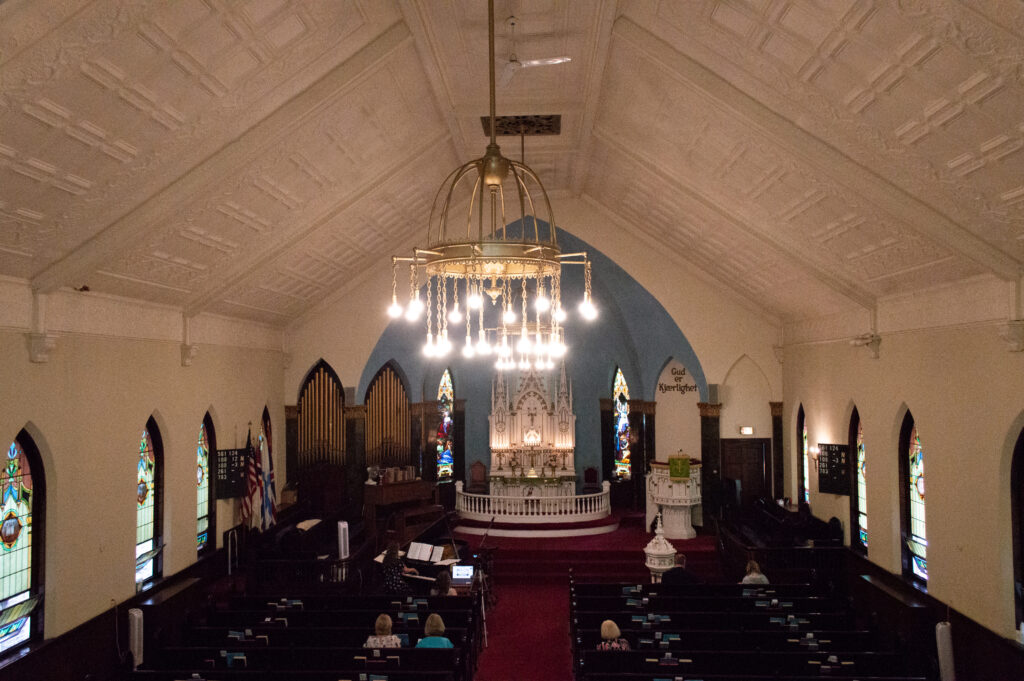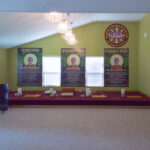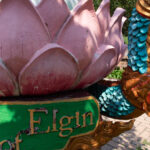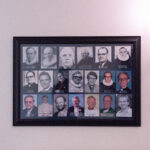Chicago

This leg of the journey took me back out into the suburbs, to the great expanse known collectively as Chicagoland. Like most American cities, the vast majority of people who say they are from Chicago are actually from one of its dozens of suburbs. Today I am going to one of those suburbs, the mighty Elgin, Illinois. This time I am graciously driven by Mrs. Strom, my friend’s mom. Elgin is a town to the west of Chicago perhaps best known for its large amounts of Sears catalog houses. I have no time to gawk at old houses, because today I am meeting with a Laotian Buddhist community running a summer camp in a Methodist church. My friend Daniel, an Elgin native, had helped me set up this meeting. He’d done his own historical survey of Elgin back when we were roommates in college and had local connections in the area.
The Methodist church has a nice view of surrounding woods and the local Home Depot, a welcome sight after weeks abroad. Inside, kids between the ages of 8-18 are running around trying desperately to win a scavenger hunt. Somebody points me in the direction of the gymnasium where a buffet of Laotian dishes is set up alongside chicken nuggets and chips. It is here that I meet Aloune, one of the elders who to my surprise is not elderly. He encourages me to grab some food, and then we sit down at a folding table.
Aloune recounts the following. The Lao community made their home here in the industrial suburb of Elgin over the course of the past few decades. Good-paying jobs in local factories began to attract immigrants all the way back in the 1960s (1). When war broke out officially in Vietnam and unofficially/unconstitutionally in the rest of Southeast Asia, church sponsors began helping people move to Elgin. At its height, Elgin had between 10,000-15,000 people of Laotian descent, the largest in the state of Illinois. These days, the Laotian community is spread throughout the Chicagoland area, largely comprised of second, third, and fourth generation Laotian-Americans.
Early on, community members began meeting for Buddhist prayers in an apartment. They eventually set up Watlao Buddha Samaggi, the first Buddhist temple in Elgin created by and for the Laotian community. You can still visit today and see the walls Aloune and his father painted. As time went by, more land was bought and a second and eventually third temple were established. The original Watlao temple had become too popular, attracting literally thousands of people for Buddhist New Year celebrations. Back in those days, the city instated a curfew after neighbors complained about the crowded parking situation and noise. Aloune explains that it is customary to donate money to temples on New Years, which is how the money was raised for the other two temples. Today each temple operates independently, catering to different purposes.
The summer camp that I’d crashed was conceived of by the elders to help the newer generations stay tied to their roots. Local kids partner with elders from the community–elders in the sense of Aloune who is maybe forty and the college kids who lead the camps–as well as with leaders from other religious communities. Pastors, rabbis, and imams are all welcome to teach the kids at this camp, not all of whom are Buddhist or Laotian. The camp reflects the city of Elgin, a constant meeting of Americans with hyphenated identities holding onto transplanted traditions.
Aloune has to get back to the scavenger hunt, so he introduces me to a woman named Ket. She says that I can meet her at one of the temples after she drops her kids off at home. I say bye to Aloune and the other elders (again, as in 30-40 year old elders) and text Mrs. Strom who thankfully is watching her friend’s dog nearby. We go down a winding road that looks like a dead end until we see a white elephant statue with a Buddhist wheel of dharma on top. In the center of the wheel the acronym “USA” is painted in the colors of the American flag. Mrs. Strom and I wander around in the summer heat until Ket pulls up. At that same moment, a monk in a robe steps out of the house, looking confused. The monk, Ket explains, had probably just landed today from Laos, and was undoubtedly jet lagged. Despite this, he is generous enough to spend some time sitting with me and talking about life as a Buddhist monk. He explains the five precepts which (Theravada) Buddhist monks live by:
- Don’t kill living beings
- Don’t steal
- Don’t lie
- Don’t have immoral sexual relations
- Don’t get intoxicated
Either he put particular emphasis on “no intoxication” or I had a guilty conscience due to copious Old Styles shared amongst friends the night before. He also explains that monks can only eat food that is given to them. In Laos, monks would go from house to house and get bits and pieces of food from their community. In car-centric America, people bring the monks food. I also learn that anyone can come and live in the temple, they just have to abide by the five rules and help out with chores. Some temples have monks that live there full time while others have a rotating cast of monks. Here at the Lao Buddhist Temple of Elgin, most of the monks come from Laos for as long as their visas allow.
The temple itself is a house on the edge of Elgin seated on a large piece of land. The community members have been pruning the grounds for years, creating a meditative and contemplative space for those looking to walk the spiritual path. There are trees and a creek that runs parallel to a silent walking path that most monks visit every morning. Despite the sticky humidity, there is a sense of peace and tranquility in the air. Mrs. Strom and I thank Ket and the monk and make our way back.
1: Vientiane, the capital of Laos, has been Elgin’s sister city sine 1967.

Sunday rolls around and my friend Konrad and I head to Logan Square. We meet up with another friend, Gabe Johnson, a man who in a past life was no doubt a wandering holy man. His hair is bright red and he towers above any crowd, so we have no difficulty spotting him. Gabe is taking us to the church his dad is a pastor at, the Norwegian Lutheran Memorial Church also known as the Minnekirken. I’d seen the outside of the church many times before–it’s one of those landmark churches that every city has that is mainly spoken about when giving directions. This would be my first time stepping inside though, and my first church where the immigrants were from Europe.
We walk in and are greeted by an elderly man with an unknown accent frantically asking us if we could charge his phone. None of us have a charger, and each of us is confused by this greeting, so we apologize and continue forward. The interior of the church looks exactly how you think it would from the outside. There are ornate moldings and decorations, stained glass, and the familiar smell of twentieth century carpet. There are also signs of changing times, particularly a large part of the ceiling that fell off in a recent storm. Its remnants are still up in the balcony where my friends and I go to watch a congregation member ring the bell. We then make our way past the ceiling rubble back down to our seats. Gabe’s sister sits down with us and the service begins.
Minnekerkin is the only Norwegian speaking church left in Chicago, and only one of two (2) left in the country. The generation which continues speaking Norwegian is mainly American born, but a handful of Norwegian born immigrants still line the pews on Sunday mornings. A woman wearing glasses leads the congregation in a number of Norwegian prayers before the hymns begin. Then Pastor Johnson gives a sermon in English.
Once the service ends, we go downstairs for coffee and pastries (this is technically not fika but it basically is, but if I call it fika I’m sure both Swedes and Norwegians will get upset so…). We sing happy birthday to the man who’d been asking about charging his phone and then I am introduced to Kari Diesen-Dahl. She is one of the church elders and one of the most instantly magnetic people I’ve met. Kari was part of the last waves of Norwegians who arrived to Chicago and has been attending this church longer than most of the congregation.
Kari recounts to me the story of the Minnekirken. Logan Square was once a hub for Scandinavian immigrants, the first waves coming around the turn of the twentieth century. Norwegian Lutherans would meet in homes at first, eventually raising funds for a church of their own. The cornerstone of the church was laid way back in 1908, with the foundation and basement laid first. The partially finished basement served as the initial meeting space while the rest of the church was constructed. By 1912, the church was finally finished an stayed in operation over the course of the next sixteen years. In 1928 the church suddenly closed as the Great Depression began to unfold. The congregation joined up with another Norwegian church until 1934 when they reopened as the Norwegian Lutheran Memorial Church. Ninety years later, they are still going, meeting in Logan Square to worship, hang out, and bake pastries.
Kari herself came from Norway in 1959 and has been a member since 1960. The church was still a community meeting point in those days, complete with a Sunday School and youth choir. Like most churches with a strong liturgical background, attendance has gone down over the years. Covid led most of the congregation online, and many chose to stay online. Of Kari’s generation, most Norwegians made their way back from the United States since Norway had become a desirable place to live for the first time in decades. Today Norway is synonymous with utopia, at least by the standards of debt-crippled Americans living in fear of the disease-to-bankruptcy pipeline. Kari still regularly goes back, often with her children who are fluent in Norwegian. I thank her and within seconds of rejoining her friends she has made everyone laugh. She is undoubtedly the life of the party here at the Minnekirken. Konrad, Gabe, and I head upstairs and make our way to the movie theater for Barbenheimer.
2: The other is unsurprisingly in Minneapolis.








